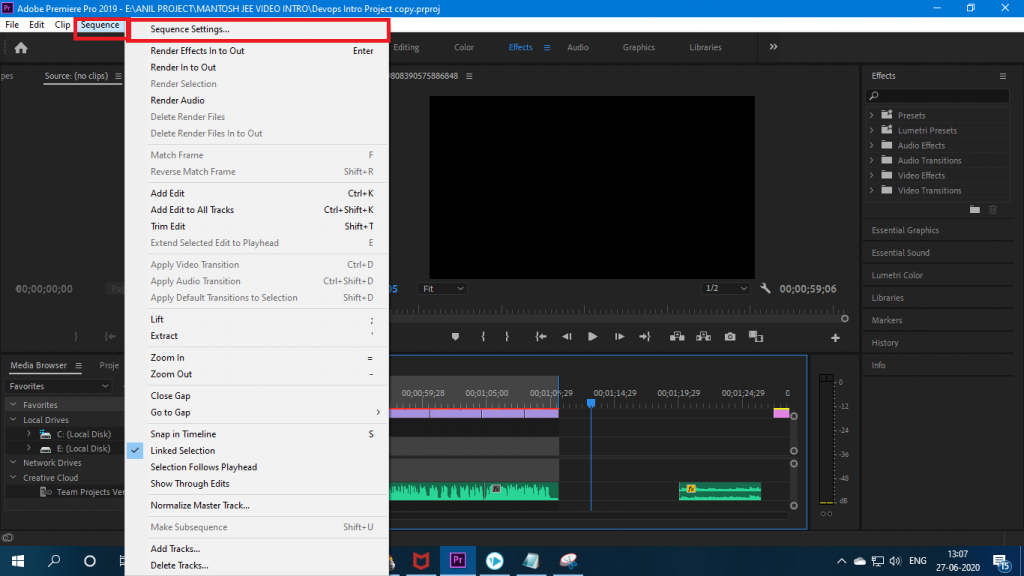
Next, if the Match Source button is pressed in the Export Settings, exPostProcessParamsRec.doConformToMatchParams will be true. This will add the Match Source button to the Video tab in the Export Settings. The exporter must set e圎xporterInfoRec.canMatchSource to true. If you don’t set that flag, parameters may appear out of order after a change. Then, set exParamChangedRec.rebuildAllParams to true before returning. Use ChangeParam in the Export Param Suite to make the change.
ADOBE PREMIERE PRO CC 2014 SEQUENCE PRESETS UPDATE
The time to update is during the exSelValidateParamChanged selector. Parameters can be updated dynamically based on user interaction with any related parameter. When the exporter is sent exSelExport to export, get the user-specified parameter values using the Export Param Suite. Then provide the localized strings and min/max parameter values during exSelPostProcessParams.

Beyond the standard parameters, custom defined parameters can be added using the Export Param Suite.įirst register the parameters during exSelGenerateDefaultParams. Starting in CS6, the Export Standard Param Suite provides a way to add several basic sets of parameters, whether for video, audio, still sequences, etc. However, you will want to test your exporter in Premiere Pro, to make sure the behavior is the same as when running in Media Encoder. It may be faster to developing exporters using Media Encoder, since it is a lighter-weight application.
ADOBE PREMIERE PRO CC 2014 SEQUENCE PRESETS CODE
Step through the code in your debugger to learn the order of events. Start your plugin by modifying the SDK sample. Adding new Preview File Formats to Existing Editing Modes.Handling a Pause or Cancel by the User (Pull Model only).


However, you can make an effect start and stop at specific times or make the effect more or less intense by using keyframes. Alternatively, you can view and adjust effects for a clip in the Timeline panel by expanding its track and selecting the proper viewing options.īy default, when you apply an effect to a clip, the effect is active for the duration of the clip. To view and adjust effects for a selected clip, use the Effect Controls panel. You can also temporarily disable any effect, which suppresses the effect without removing it, or you can remove the effect completely. You can apply Standard effects to more than one clip at a time by first selecting all the clips you want to affect. You can apply the same effect multiple times, using different settings each time. Alternatively, select the clip and double-click an effect in the Effects panel to apply it. You can apply one or more Standard effects to a clip by dragging effect icons from the Effects panel to a clip in the Timeline panel. These two tools will allow you to do most of your basic editing. Using the Razor Tool (C), you can split your clip in two or cut out a section in the middle. Your cursor will turn into a red arrow symbol when you position it at the inner or outer edge of the clip, allowing you to lengthen or shorten it. Now that you’ve got your clip on the timeline, you can move it around and adjust its length on either end using the Selection Tool (V). Once you’ve made your selection using in and out points, you can either drag the clip onto the timeline (from the Project or Source Monitor windows) or using the Insert/Overwrite buttons. You can also use the I and O keys to input in and out points. You will always be able to tweak the length of this selection once you place your clip on the timeline, so no need to worry about getting the perfect selection now. The grey bar under the clip shows your clip selection. Use the Mark In () buttons to set the desired start and end for this clip. Double click on one of the video files you have imported in your project panel this will load the clip into your Source Monitor.


 0 kommentar(er)
0 kommentar(er)
